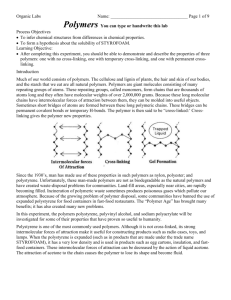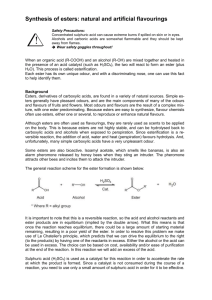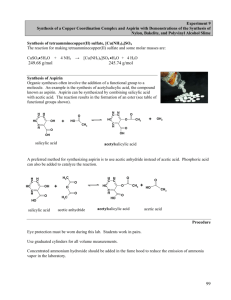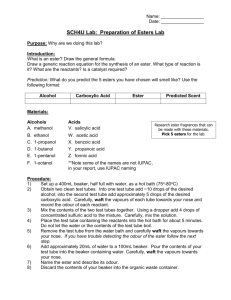Ester PURPOSE: To make an ester and note the fragrance
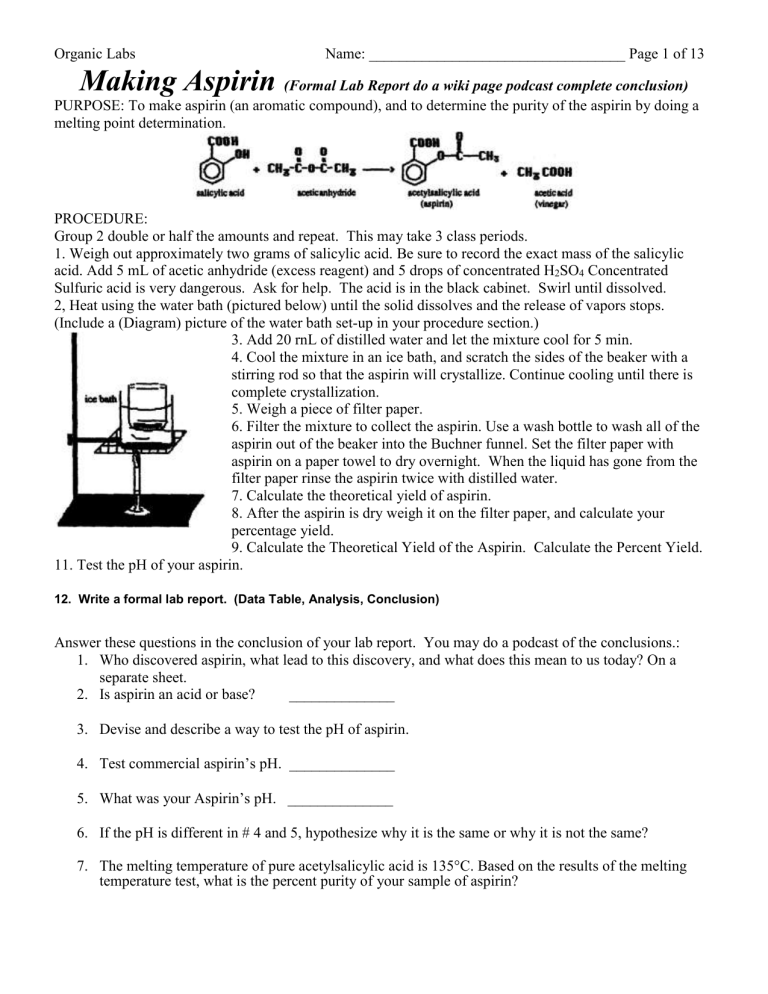
Organic Labs Name: __________________________________ Page 1 of 13
Making Aspirin
(Formal Lab Report do a wiki page podcast complete conclusion)
PURPOSE: To make aspirin (an aromatic compound), and to determine the purity of the aspirin by doing a melting point determination.
PROCEDURE:
Group 2 double or half the amounts and repeat. This may take 3 class periods.
1. Weigh out approximately two grams of salicylic acid. Be sure to record the exact mass of the salicylic acid. Add 5 mL of acetic anhydride (excess reagent) and 5 drops of concentrated H
2
SO
4
Concentrated
Sulfuric acid is very dangerous. Ask for help. The acid is in the black cabinet. Swirl until dissolved.
2, Heat using the water bath (pictured below) until the solid dissolves and the release of vapors stops.
(Include a (Diagram) picture of the water bath set-up in your procedure section.)
3. Add 20 rnL of distilled water and let the mixture cool for 5 min.
4. Cool the mixture in an ice bath, and scratch the sides of the beaker with a stirring rod so that the aspirin will crystallize. Continue cooling until there is complete crystallization.
5. Weigh a piece of filter paper.
6. Filter the mixture to collect the aspirin. Use a wash bottle to wash all of the aspirin out of the beaker into the Buchner funnel. Set the filter paper with aspirin on a paper towel to dry overnight. When the liquid has gone from the filter paper rinse the aspirin twice with distilled water.
7. Calculate the theoretical yield of aspirin.
8. After the aspirin is dry weigh it on the filter paper, and calculate your percentage yield.
9. Calculate the Theoretical Yield of the Aspirin. Calculate the Percent Yield.
11. Test the pH of your aspirin.
12. Write a formal lab report. (Data Table, Analysis, Conclusion)
Answer these questions in the conclusion of your lab report. You may do a podcast of the conclusions.:
1.
Who discovered aspirin, what lead to this discovery, and what does this mean to us today? On a separate sheet.
2.
Is aspirin an acid or base? ______________
3.
Devise and describe a way to test the pH of aspirin.
4.
Test commercial aspirin’s pH. ______________
5.
What was your Aspirin’s pH. ______________
6.
If the pH is different in # 4 and 5, hypothesize why it is the same or why it is not the same?
7.
The melting temperature of pure acetylsalicylic acid is 135°C. Based on the results of the melting temperature test, what is the percent purity of your sample of aspirin?
Organic Labs Name: __________________________________ Page 2 of 13
Synthesis of Esters (handwritten)
Esters are an important class of organic compounds which are characterized by the following generic formula.
Low molecular weight esters have pleasant odors and are responsible for many of the distinctive odors in a wide variety of fruits and flavorings. Esters can be readily prepared from their corresponding carboxylic acid via a condensation reaction with an alcohol. Generally this reaction is catalyzed by strong acids in solution.
The equilibrium constant for the reaction between primary alcohols and unhindered carboxylic acids is approximately four. If equal quantities of acid and alcohol are used the reaction gives a product yield of only
67%. In order to make esters in high yields the equilibrium must be shifted using LaChatelier’s principle. In this experiment you will synthesize a series of low molecular weight esters from their corresponding acids and alcohols. In order to generate the esters efficiently you will use an excess of alcohol and in some cases you will remove the water as a low boiling azeotrope. You will then attempt to identify the characteristic odor of each of the esters you have made. Use the table of esters and structures on the following page to assist you in determining which acids and alcohols to use.
Many esters have the characteristic property of a pleasant odor. As such, they are used as artificial flavors and perfumes. Have you ever tasted peppermint gum or banana-flavored ice cream? These flavors are most likely due to an organic compound known as an ester. Not all esters have odors, some are odorless, too. An example of an odorless ester would be vegetable oil.
Esters are formed by the process of dehydration synthesis using an alcohol with an acid. Their names are formed from the very alcohol and acid used in their making. For example, when making the ester methyl salicylate (oil of wintergreen), the alcohol and acid used would be methanol and salicylic acid, respectively. This ester has an agreeable “peppermint” odor. Another example would be the ester butyl formate which is produced when reacting butyl alcohol with formic acid.
When an organic acid (RCOOH) reacts with an alcohol (R’OH), water is removed and an ester is formed. This process is an example of dehydration synthesis.
Some artificial flavors are formed by the mixing of esters in an attempt to duplicate the flavor or odor of a natural substance. For example, the odor of raspberries is due to a mixture of isobutyl formate and isobutyl acetate. In this experiment you will make three different esters having characteristic odors of banana, peppermint, and fruit essences. The product formed will be quite crude; however, you will be able to detect the three different odors, as well as experience the basic method of producing esters.
Organic Labs Name: __________________________________ Page 3 of 13
MATERIALS
4 culture tubes 6 x 50 mm
4 graduated pipets with 1 inch of barrel cut-off
50 mL beaker
Use a hot plate to heat solutions.
Concentrated Sulfuric Acid (in the black fume hood at the back of the room. BE CAREFUL with this acid.)
Use the chemicals listed below.
Acetic Acid (Vinegar) with Ethanol (Ethyl Alcohol)
Salicylic Acid with Methanol (Methyl Alcohol)
PROCEDURE
1. PUT ON YOUR GOGGLES NOW! HAVE YOUR INSTRUCTOR DEMONSTRATE THE
PROPER PROCEDURE FOR DETECTING ODORS OF REAGENTS. (Wave your hand over the test tube and to bring the odor to your nose. DON’T stick you nose in the test tube.)
2. Fill a 50 mL beaker with water. Set the beaker on the hot plate. Bring the water to a gentle boil.
3. Examine the structure of the ester you wish to synthesize. Determine which carboxylic acid and which alcohol you need to use in your synthesis. See the Chart “A” on the next page. For the acid and the alcohol you need to use. Do the two labeled with a
. You may try the sweet and fruity if you have time.
4. In a 6 x 50 mm culture tube (small test tube about 2.5 inches long) obtain two drops of the carboxylic acid. If the carboxylic acid you wish to use is a solid, use about the amount which would fit inside this letter
“O”
Add six drops of alcohol and one drop of concentrated sulfuric acid. BE
VERY CAREFUL WITH THE SULFURIC
ACID.
5. Do this lab at the back left lab table near the Black
Hood. Turn on the hood while working. Make sure you turn it off when you finish for the day.
6. Wave the fumes from this mixture to your nose and carefully note and record the odor of this reaction.
7. Place the cut-off graduated pipet into the culture tube. It should form a tight seal. See diagram.
8. Boil the mixture for 3-5 minutes and observe and record any changes which take place in the reaction mixture.
9. Remove the reaction assembly from the boiling water.
10. Remove the pipet from the culture tube and carefully force out some of the vapor. Wave the fumes to your nose and carefully note and record the odor of the ester you synthesized.
11. Occasionally, the vapor is too concentrated and
“over powers” your nose. Add some water to the pipet and smell again.
Organic Labs Name: __________________________________ Page 4 of 13
Questions:
1.
In some case the odor of the synthesized ester does not exactly match the odor of the fragrance found in nature. What might be a possible explanation for this?
2.
What is a characteristic of esters that smell good?
3.
What two types of chemicals are combined to make an ester?
4.
Identify the branches and functional groups from the structural formulas on the next page.
5.
Name the two esters you were required to make.
6.
Look up the structural formula for aspirin (an ester) and write an equation of its synthesis.
7.
Identify the odor of your ester and determine its structure. Draw the structure.
8.
Name four products that you have used or know about that have esters in them. These should different from your partners. (Think of things that smell fruity or sweet but have no fruit in them.)
9.
What type of reaction produces esters? Describe why it has this name.
10.
Which flavor worked the best for you?
11.
Write a balanced equation for each ester below: Partner 1 do odd-Partner 2 do even.
Organic Labs Name: __________________________________ Page 5 of 13
Organic Labs Name: __________________________________ Page 6 of 13
Polymers
You can type or handwrite this lab
Process Objectives
To infer chemical structures from differences in chemical properties.
To form a hypothesis about the solubility of STYROFOAM.
Learning Objective:
After completing this experiment, you should be able to demonstrate and describe the properties of three polymers: one with no cross-linking, one with temporary cross-linking, and one with permanent crosslinking.
Introduction
Much of our world consists of polymers. The cellulose and lignin of plants, the hair and skin of our bodies, and the starch that we eat are all natural polymers. Polymers are giant molecules consisting of many repeating groups of atoms. These repeating groups, called monomers, form chains that are thousands of atoms long and they often have molecular weights of over 2 000 000 grams. Because these long molecular chains have intermolecular forces of attraction between them, they can be molded into useful objects.
Sometimes short bridges of atoms are formed between these long polymeric chains. These bridges can be permanent covalent bonds or temporary H-bonds. The polymer is then said to be “cross-linked:’ Crosslinking gives the polymer new properties.
Since the 1930’s, man has made use of these properties in such polymers as nylon, polyester; and polystyrene. Unfortunately, these man-made polymers are not as biodegradable as the natural polymers and have created waste-disposal problems for communities. Land-fill areas, especially near cities, are rapidly becoming filled. Incineration of polymeric waste sometimes produces poisonous gases which pollute our atmosphere. Because of the growing problem of polymer disposal, some communities have banned the use of expanded polystyrene for food containers in fast-food restaurants. The “Polymer Age” has brought many benefits; it has also created many new problems.
In this experiment, the polymers polystyrene, polyvinyl alcohol, and sodium polyacrylate will be investigated for some of their properties that have proven so useful to humanity.
Polystyrene is one of the most commonly used polymers. Although it is not cross-linked, its strong intermolecular forces of attraction make it useful for constructing products such as radio cases, toys, and lamps. When the polystyrene is expanded (such as in products that are made under the trade name
STYROFOAM), it has a very low density and is used in products such as egg cartons, insulation, and fastfood containers. These intermolecular forces of attraction can be decreased by the action of liquid acetone.
The attraction of acetone to the chain causes the polymer to lose its shape and become fluid.
Organic Labs Name: __________________________________ Page 7 of 13
Polyvinyl alcohol can be weakly cross-linked with the hydrated borate ion. This polymer forms h non-
Newtonian gel, which has properties similar to the SLIME that is manufactured by Mattel Toy Corporation.
When kept in motion, it forms a semi-rigid mass; when held steady, it flows.
Sodium polyacrylate is a strongly cross-linked polymer which has superabsorbent properties. It can form a gel by absorbing as much as 800 times its weight of water. Currently it is used to coat seeds before planting and to remove water from diesel and aviation fuels. Some brands of disposable diapers contain this superabsorbent polymer. For more on Polymers, read Chapter 21, Section 21.3 in the textbook.
Take the necessary precautions before beginning this experiment. Wear safety goggles, apron, and gloves. Read all safety cautions in your procedures and discuss them with your teacher. It is important to use good safety techniques while conducting experiments.
Show students the dry PVA powder and the 4% Borax solution. Demonstrate the solution’s viscosity by pouring from one beaker to another. Explain how PVA and borax solutions were made. Show the structural formula of polymer chains and borate ion, In water, the borax hydrolyzes to form a borate-boric acid buffer system:
The B(OH)4 ion is believed to cross-link the polymer chains as shown in Figure 2.
Organic Labs Name: __________________________________ Page 8 of 13
Exact measurements are NOT necessary. DO NOT waste time measuring exactly
.
Introduction
Solutions of the polymer polyvinyl alcohol (PVA) and polyvinyl acetate can be made into gels by addition of a borax solution. Borax cross-links the polymer chains. In this activity you will investigate interesting properties of gels. “Slime” is a polyvinyl alcohol polymer. “Gluep’ is a polyvinyl acetate polymer.
Purpose
To observe the effects of cross-linking polyvinyl alcohol and polyvinyl acetate chains with borax. To observe the reversal of the cross-linking process.)
Safety
1. Wear protective goggles throughout the laboratory activity.
2. The polyvinyl alcohol and borax solutions are nontoxic, but wash your hands when finished. Keep the gel in plastic bag; keep off clothes and carpets.
Procedure
Part I. Making “Slime” See questions on the Questions pages.
1, Obtain 10 mL (4 good squeezes of a pipet or 2 teaspoons) PVA solution in a disposable cup.
2. Obtain a wooden stirring stick—a glass stirring rod does not work as well—and stir the PVA solution.
Note its viscosity. Is it more or less viscous than water?
3. If desired, add one drop of food color to the PVA. Stir well.
4. Measure 2.5 mL (one good squeeze of a pipet or half a teaspoon) of the borax solution in a
5. Pour the borax solution into the PVA. Stir vigorously until the gelling is complete.
6. Scrape the gel into your hands. Pat and knead it thoroughly to completely mix the components.
7. Test its properties as (density, viscosity, malleability, resistance to pressure).
8. Take the sample home in a zip-closure plastic bag.
9. Thoroughly wash your hands before leaving the laboratory and each time you handle “slime.”
Part IA: Making “Gluep”
1. Mix white glue 50:50 with water. Stir well.
2. Measure three or 4 teaspoons glue mixture into a cup. (¼ inch in the bottom of a bathroom cup.)
3. Add color and stir well with a stick.
4. Add two teaspoons (10 mL) borax solution and stir vigorously. (The “gluep” will cling around the stick and can be pulled out, usually in one blob, without much being left in the cup.)
5. Knead the “gluep” well, and observe its properties as before and compare to properties of slime.
6. Store “gluep” in a tightly sealed zip-closure bag. Throw away when it gets moldy.
7. Thoroughly wash your hands before leaving the laboratory and each time you handle “gluep.”
Part II . . Effect of Acid and Base on “Slime”
See questions on the Questions pages.
8. Place a dime-sized piece of slime on a watch glass or Petri dish. Add 2 M HCl dropwise, stirring well with the stick after each drop. When a change is noticed, record your observations.
9. Add 2 M NaOH dropwise to the same sample, stirring well with the stick after each drop. When a change is noticed, record your observations. (Repeat the procedure, if you wish.)
10. Thoroughly wash your hands before leaving the laboratory.
Part III. .
Pour 10 mL (4 good squeezes of a pipet or 2 teaspoons of acetone into a small beaker. Put some expanded polystyrene (or a Styrofoam cup) into the acetone. After a few minutes, examine the polystyrene. Using a metal scoop or wooden stick lift out the polystyrene and place it .onto a paper towel. Let it dry for several
Organic Labs Name: __________________________________ Page 9 of 13 minutes. Then using an pipet place a few drops of the acetone from the petri dish onto a watch glass and allow to evaporate.
Part IV: This part requires exact measurements.
Mass a small plastic cup and record the mass. Use the big balance. Mass 0.025 grams of sodium polyacrylate into a small plastic cup. Add distilled water until the resulting gel is soupy. Re-mass. Calculate the mass of H
2
O/gram of sodium polyacrylate. Dispose of the cup and contents in the garbage NOT the sink.
Show calculations on the appropriate question on the questions page.
Part I. Implications and Applications
1.
Was the PVA more or less viscous than water? Explain your reasoning.
2.
Compare to properties of slime and the Gluep.
3.
Is covalent or hydrogen bonding responsible for the cross-linking?
4.
Why is borax [B(OH)
4
]
-
is the active ingredient], an effective cross-linker?
5.
Draw a representation of the polymer chains: (Be sure to include some water molecules in your drawing; after all, both solutions are 96% water!) a.
before cross-linking. b.
after cross-linking.
Part II. Data Analysis and Concept Development
1. How many drops of HCl were necessary to “break the gel?”
__________________________
2. How many drops of NaOH were required to re-gel the polymer? __________________________
3. Write the equation for the reaction of HCl with NaOH.
4. What happened to the molecule when you added HCl?
Organic Labs
Part IV:
Name: __________________________________ Page 10 of 13
1. What is the mass of the H
2
O/gram of sodium polyacrylate that was absorbed?
Questions:
1. What evidence suggests that the Styrofoam peanuts did not significantly dissolve in the acetone?
2. The slime that you prepared in Procedure 2 stretches when pulled slowly, but breaks if pulled quickly.
Based on its structure, offer an explanation.
3. Expanded polystyrene food containers have many useful properties. They are inexpensive, low in density, and are excellent insulators for both hot and cold foods. Unfortunately, the disposal of these containers presents a land-fill problem. Using what you have learned in this experiment suggest a method for reducing the volume of expanded polystyrene waste.
4. What is the advantage of coating a seed with sodium polyacrylate polymer before planting?
5. What does viscous mean? Give another example of a viscous substance? What makes a substance viscous?
6. Why is PVA (polyvinal alcohol) solutions so viscous?
7. How is a gel like a liquid? solid?
8. Why does acid destroy the properties of the gel?
9. How have the properties changed after addition of NaOH?
10. Why does the base restore the gel’s properties?
11. In the lab you did something like the diagram depicts. Explain the diagram and what does it refer to:
Organic Labs Name: __________________________________ Page 11 of 13
12. Write a brief paragraph Slime and Gluep describing the properties of each. What makes them fun?
12.
What natural material is imitated by rayon?
13.
Discuss (one paragraph each) 2 environmental problems with manmade polymers.
14.
Which chemical in this lab can absorbs up to 800 times its own weight?
_________________________________________
15.
Discuss the process of cross-linking in a gel formation. Which experiment s demonstrated this process?
Organic Labs Name: __________________________________ Page 12 of 13
Polyurethane Foam System email
There are many forms of polyurethane such as fibers, coatings, elastomers, flexible foams, and rigid foams.
The foam produced in this system is a rigid foam that is used in furniture, packaging, floatation devices, cigarette filters, and many other items.
You can produce a rigid polyurethane foam by reacting a difunctional isocyanate with a polyfunctional alcohol, which results in a highly cross-linked polymer system. The reagents involved are specially formulated components Part A an Part B. The side reaction of the dilsocyanate with water in combination with the vaporization of a volatile nonflammable blowing agent provides expanding gases which cause the foam to expand and form a porous structure as the strongly exothermic step polymerization reaction occurs.
Part A is a viscous cream colored liquid containing a polyfunctional alcohol, a silicone surfactant, a blowing agent, and a catalyst for the reaction. The blowing agent is trichlorofluoromethane, Freon 11. The two reactions involved are shown below. That involving the reaction of the isocyanate with water produces a carbamic acid which decomposes to yield CO
2
gas and an amine. The exothermic nature of the reaction serves to volatilize the blowing agent and. both effects serve to open the polymer network up into a foamed structure.
Part B is a dark brown viscous liquid containing a diisocyanate.
A general reaction for the polyurethane foam production is:
The competing reaction of the dilsocyanate with water is:
Materials needed:
Polyurethane foam system Parts A and B
2 disposable (bathroom) cups paper towels fume hood, or well-ventilated area wooden stick to stir with acetone goggles, chemical resistant lab apron food coloring
Use 2-3 teaspoons of Part A and 2-3 teaspoons of Part B. (about ¼ inch of each in the bathroom cup.) Do not use a graduated cylinder. You may want to put a drop of food coloring into Part A before adding Part B.
Stir vigorously until the foam begins to expand and change color slightly. It will expand to 25-30 times its volume and the wood stick may be used to support the foam as it rises, however be sure to remove it while the foam is still soft or plan for it to be a permanent part of the rigid foam formed. Any equal volume mixture may be used, but plan on the correct amount of expansion. To color the foam, add the food coloring to the lighter of the components, Part A, and mix well. The foam dries in 5-10 minutes and should not be handled until then. After that time, any unreacted isocyanate will have reacted with the moisture in the air.
Touch the out side of the cup.
Organic Labs
Questions:
1.
What is exothermic mean?
Name: __________________________________ Page 13 of 13
2.
Site proof that the reaction is or is not exothermic?
3.
In the formulas on the previous page, what does the “R” stand for? What would replace this “R”?
4.
Discuss your observations and conclusions. (Cross-linking might be a good concept to include

